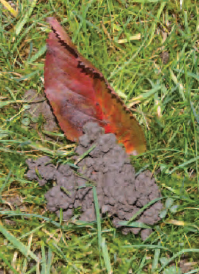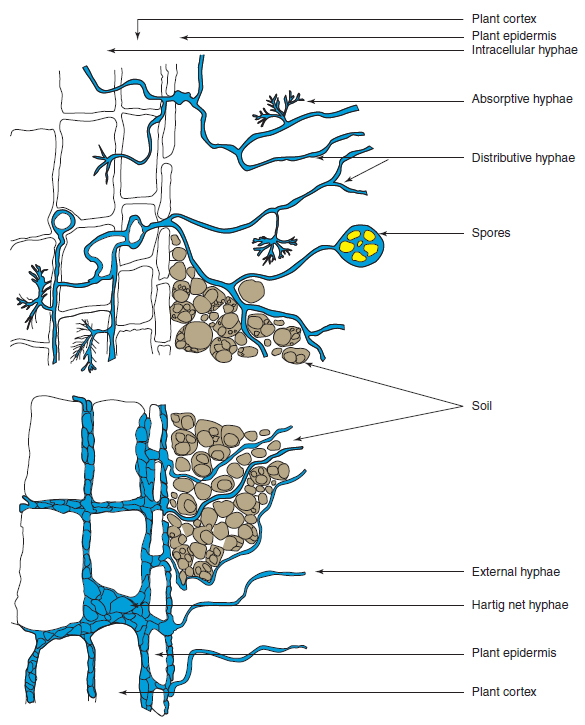Living organisms in the soil
ContentAs in any other plant and animal community the organisms that live in the soil form part of the food webs. The main types present in any soil are the primary producers which are those capable of utilizing the sun’s energy directly, synthesizing their own food by photosynthesis, such as green plants (see photosynthesis), the primary consumers which are those organisms which feed directly on plant material, and secondary consumers which feed only on animal material. In practice, there are some organisms that feed on both plants and animals and also parasites living on organisms in all categories many of which are pests or diseases of horticultural plants. Decomposers are an important group, which have the special function within a community of breaking down dead or decaying matter into simpler substances with the release of inorganic salts, making them available once more to the primary producers. Primary decomposers are those organisms that attack the freshly dead organic matter. These include earthworms and some species of arthropods and fungi. Fungi are particularly important in the initial decomposition of fibrous and woody material. Secondary decomposers are those organisms that live on the waste products of other decomposers and include bacteria and many species of fungi. Plant roots These are important as contributors to the organic matter levels in the soil. They move soil particles as they penetrate the soil and grow in size. This rearrangement changes the sizes and shapes of soil aggregates and when these roots die and decompose, a channel is left which provides drainage and aeration. Root channels are formed over and over again unless the soil becomes too dense for roots to penetrate. Roots absorb water from soils and dry it, causing those with a high clay content to shrink and crack. This helps develop and improve structures on heavier soils.
Earthworms There are ten common species of earthworm in Britain that vary in size from Lumbricus terrestris, which can be in excess of 25 cm, to the many small species less than 3 cm long (see Figure 18.1). The main food of earthworms is dead plant remains. Casting species of earthworms are those that eat soil, as well as organic matter, and their excreta consist of intimately mixed, partially digested, finely divided organic matter and soil. Many species never produce casts and only two species regularly cast on the surface giving the worm casts that are a problem on fine grass areas, particularly in the autumn (see Figure 18.2). It has been estimated that in English pastures the production of casts each year is 20–40 t/ha, the equivalent of 5 mm of soil deposited annually. This surface casting also leads to the incorporation of the leaf litter and the burying of stones. However, L. terrestris is the organism mainly responsible for the burying of large quantities of litter by dragging plant material down its burrows. The network of burrows which develops as a result of worm activity is an important factor in maintaining a good structure, particularly in uncultivated areas and in soils of low clay content. Some species live entirely in the surface layers of the soil others move vertically establishing almost permanent burrows down to two metres. Earthworm activity and distribution is largely governed by moisture levels, soil pH, temperature, organic matter and soil type. Most species tend to be more abundant in soils where there are good reserves of calcium. Earthworm populations are usually lower on the more acid soils, but most thrive in those near neutral. Worm numbers decrease in dry conditions, but they can take avoiding action by burrowing to more moist soil or by hibernating. Each species has its optimum temperature range; for L. terrestris this is about 10°C, which is typical of soil temperatures in the spring and autumn in the UK. Soils with low organic matter levels support only small populations of worms. In contrast, compost heaps and stacks of farmyard manure have high populations. In oak and beech woods where the fallen leaves are palatable to worms, their populations are large and they can remove a high proportion of the annual leaf-fall. This also happens in orchards unless harmful chemicals such as copper have reduced earthworm populations. Light and medium loams support a higher total population than clays, peat and gravelly soils. Slugs, snails and arthropods (such as millipedes, springtails and mites), and nematodes are also found in high numbers and play an important part in the decomposition of organic matter. Several species are also horticultural pests (see Horticultural pests). Bacteria Bacteria are present in soils in vast numbers. About 1000 million or more occur in each gram of fertile soil. Consequently, despite their microscopic size, the top 150 mm of fertile topsoil carries about one tonne of bacteria per hectare. There are many different species of bacteria to be found in the soil and most play a part in the decomposition of organic matter. Many bacteria attack minerals; this leads to the weathering of rock debris and the release of plant nutrients. Detoxification of pesticides and herbicides is an important activity of the bacterial population of cultivated soils. Soil bacteria are inactive at temperatures below 6°C, but their activities increase with rising temperature up to a maximum of 35°C. Bacteria which are actively growing are killed at temperatures above 82°C, but several species can form thick-walled resting spores under adverse conditions. These spores are very resistant to heat and they survive temperatures up to 120°C. Partial sterilization of soil can kill the actively growing bacteria, but not the bacterial spores. The growth rate and multiplication also depends upon the food supply. High organic matter levels support high bacteria populations so long as a balanced range of nutrients is present. Bacteria thrive in a range of pH 5.5–7.5; fungi tend to dominate the more acid soils. Aerobic conditions should be maintained because the beneficial organisms, as well as plant roots, require oxygen, whereas many of the bacteria that thrive under anaerobic conditions are detrimental. Fungi The majority of fungi live saprophytically on soil organic matter. Some species are capable only of utilizing simple and easily decomposable organic matter whereas others attack cellulose as well. There are some important fungi that can decompose lignin, making them one of the few primary decomposers of wood and fibrous plant material. Several fungi in the soil are parasites and examples of these are discussed in Horticultural diseases and disorders. Fungi appear to be able to tolerate acid conditions and low calcium better than other micro-organisms and are abundant in both neutral and acid soils. Most are well adapted to survive in dry soils, but few thrive in very wet conditions. Their numbers are high in soils rich in plant residues but decline rapidly as the readily decomposable material disappears. The bacteria persist longer, where present, and eventually consume the fungal remains. The rhizosphere The rhizosphere is a zone in the soil that is influenced by roots. Living roots change the atmosphere around them by using up oxygen and producing carbon dioxide (see respiration). Roots exude a variety of organic compounds that hold water and form a coating that bridges the gap between root and nearby soil particles. Micro-organisms occur in greatly increased numbers and are more active in proximity to roots. Some actually invade the root cells where they live as symbionts. The Rhizobium spp. of bacteria lives symbiotically with many legumes (see nitrogen cycle).
Symbiotic associations involving plant roots and fungi are known as mycorrhizae (see Figure 18.3). There is considerable interest in exploiting the potential of mycorrhizae, which appear to be associated with a high proportion of plants especially in less fertile soils. In this symbiotic relationship the fungus obtains its carbohydrate requirements from the plant. In turn, the plant gains greater access to nutrients in the soil, especially phosphates, through the increased surface area for absorption and because the fungus appears to utilize sources not available to higher plants. Most woodland trees have fungi covering their roots and penetrating the epidermis. Orchids and heathers have an even closer association in which the fungi invade the root and coil up within the cells. The association appears to be necessary for the successful development of the seedlings. Mycorrhizal plants generally appear to be more tolerant of transplantation and this is thought to be an important factor for orchard and container grown ornamentals. |






